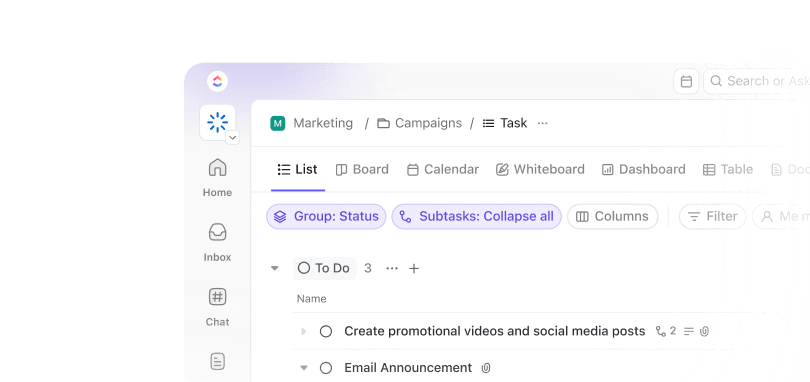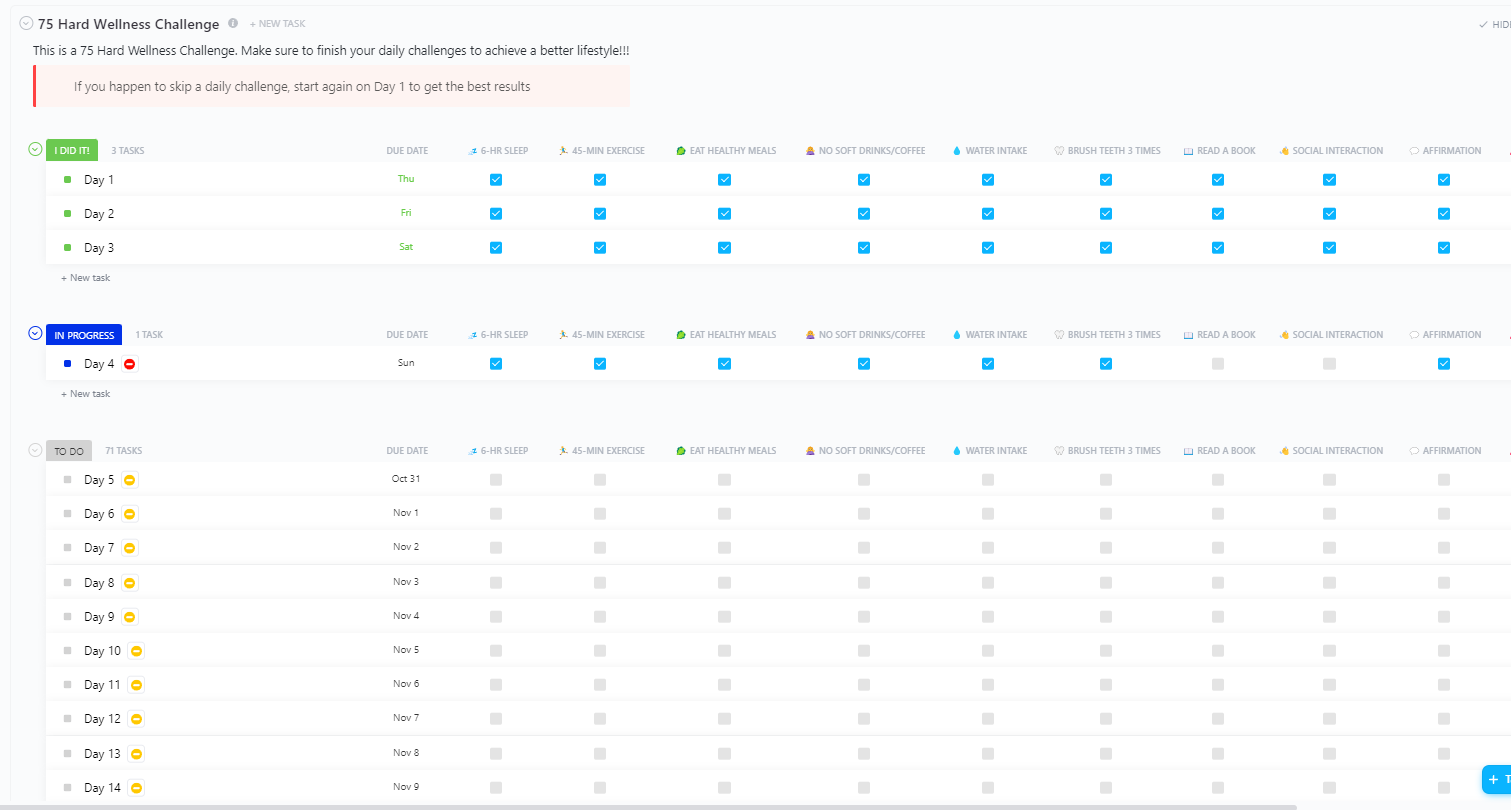The one percent improvement method has always been the most elegant entry in the self-improvement sweepstakes.
Its sales pitch is irresistible because it’s based on math, and math feels like certainty: get one percent better every day, the thinking goes, and you’ll be ~37 times better in a year.

It’s a beautiful, clean, exponential curve. The problem, of course, is that human beings are not.
We are messy, inconsistent, and prone to getting distracted by a fascinating bird outside the window.
We try to live by the elegant curve, but our progress chart ends up looking less like a stock portfolio and more like a seismograph.
🌀 Real life is non-linear: Progress isn’t a staircase—it’s a heart monitor. Peaks, dips, stalls, relapses, repeat.
Soon, the only thing compounding is a vague sense of guilt.
But what if the problem isn’t our fallibility, but the formula we were given?
This isn’t an argument against the one percent method of self-improvement. It’s a rescue mission.
We’re here to salvage a brilliant philosophy from the tyranny of its own somewhat misleading math and figure out how this powerful tool is actually meant to be used.
- The Legend of 37x Improvement
- When Perfect Math Hits an Imperfect Reality
- Sharpening the Chisel, Not Just Hitting the Stone
- How to Sharpen Your Chisel
- From Theory to Action: Building Your System in ClickUp
- Where the One Percent Method Fits and Fails
- Stop Counting, Start Designing
- Frequently Asked Questions
The Legend of 37x Improvement
The one percent method started on the factory floors of post-war Japan.
Companies like Toyota needed a way to rebuild, and they found it in a philosophy called “kaizen”: Japanese for “continuous improvement”.
The idea was straightforward: make a multitude of minor, relentless improvements—shaving a second off a process, eliminating one wasted movement—and the combined effect would lead to massive gains in quality and efficiency. This concept is also known as the aggregation of marginal gains.
And it works. Kaizen has been the quiet engine of industrial excellence and business process improvement.
👀 Did You Know? It wasn’t just manufacturing companies that adopted the kaizen philosophy. Even the notoriously complex world of aerospace and defense got in on the act. Lockheed Martin, a company responsible for building some of the most advanced military aircraft in the world, became a major ad for kaizen.
The results were startling. Between 1992 and 1997, Lockheed managed to shave 38% off its manufacturing costs, cut its inventory in half, and slice the delivery time for an aircraft from 42 months down to 21.5. As a final, almost absurdly specific testament to their obsession, they took the time required to move a part from receiving to stocking and cut it from 30 days down to just four hours.
Then, Kaizen found sports.
Specifically, it found the British cycling team, an organization that had turned not winning into a kind of national tradition. In over a century, they had collected a single gold medal.
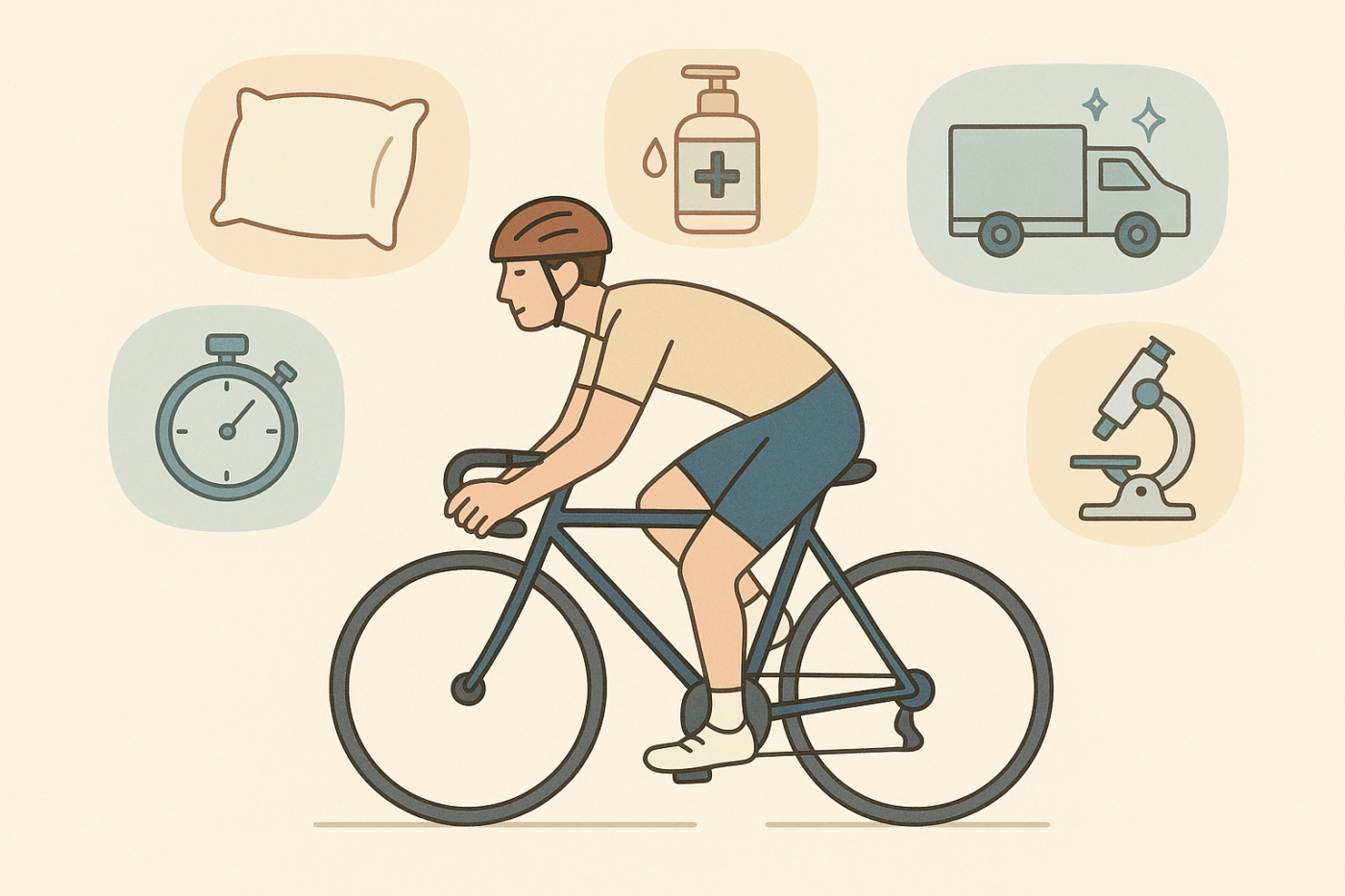
The team’s new performance director, Sir Dave Brailsford, decided the problem wasn’t a lack of talent but a lack of process. He imported the factory-floor of Kaizen and applied it to his team.
His thesis was simple: if you broke down everything it takes to ride a bike and improved each component by just one percent, the cumulative gains would make you unstoppable.
Strange but effective
In a bid to ensure his riders could extract greater performance, Sir
Dave Brailsford picked some…unconventional optimization methods:
- He started with improving the obvious things, like tire weight and rider nutrition. Simple enough
- Then the project veered into the territory of clinical paranoia. A surgeon was brought in to teach everyone a better hand-washing technique to cut down on colds
- Riders were given specific pillows and mattresses to standardize their sleep posture
- The inside of the team truck was painted a brilliant white, not for aesthetics, but to make it easier to spot tiny specks of dust that might foul up the bike’s mechanics
Sir Brailsford’s method was weird. It was borderline comical. But critically, it was brutally effective.
The team went on to vacuum up gold medals at the Olympics and win five Tour de France titles in six years, and a team that had become the national punchline had now become an empire.
But the person who took that concept and packaged it for the rest of us was James Clear (the most apropos name, ever).
In his book Atomic Habits, he distilled the grand, obsessive strategy of the British cyclists into a simple, personal mantra: get one percent better every day.
📚 How the message changed!
Kaizen → elite performance science
Atomic Habits → personal development slogan
Same idea, different level of rigor.
He attached it to that irresistible piece of math—that a tiny daily gain compounds into a 37x improvement over a year.
And with that, the legend was complete. A powerful industrial philosophy, proven in elite sport, was now a simple formula for personal transformation.
The promise was clear: small, consistent effort, applied daily, would inevitably lead to revolutionary success. The only problem is, it rarely works like that in the real world.
When Perfect Math Hits an Imperfect Reality
The legend of the one percent improvement method is a clean, logical machine.
But the moment you drive it off the lot and onto the messy, potholed streets of real life, the wheels come off. The machine hits a couple of inconvenient truths, the first of which is a particularly stubborn law of physics.
Beginner’s discount vs. expert’s tax
The 37x promise of the one percent improvement method rests on a quiet, fatally flawed assumption: that every one percent gain costs the same amount of effort.
Anyone who’s actually tried to get good at anything knows this is, to put it mildly, not true.
When you’re new to a skill, the first few gains are ridiculously cheap. You’re fixing huge, obvious mistakes, and the improvement is so fast it feels like magic. This is the beginner’s discount, and it’s where the idea of getting one percent better every day feels most real.
But once you’re no longer a beginner, you start paying the expert’s tax. Let’s understand this with a simple example:
- The beginner: A novice at the gym can add one percent to their deadlift every week for months. They’re a genius. They’re a prodigy. They are, in fact, simply new
- The expert: An elite powerlifter, on the other hand, will spend an entire year training for that same one percent gain. Their progress is measured in ounces, not pounds, and is paid for with a mortgage of sweat and boredom
⚡ Early gains feel magical because you’re fixing obvious flaws. Then progress slows, and the 1% rule gets brutally expensive.
The popular version of this method forgets to mention that the 300th improvement might cost you a thousand times the effort of the first.
It’s a mathematical curve that gets brutally steep, and it’s the first reason the elegant formula so often crashes and burns.
In other words, as this Redditor correctly notes:
The Consolation Prize
When the promise of 37x returns proves to be a fantasy, we do what any sensible person would do: we lower our expectations.
We trade the grand, mathematical promise for a more modest and forgiving explanation. “Okay,” we tell ourselves, “so maybe it’s not a magic formula. Maybe the whole point is just to break down big, scary goals into smaller, less intimidating chunks.”
This is an incredibly popular consolation prize, mostly because it’s not wrong. It’s just not the point.
A perfectly good butter knife
The research is clear on this: breaking a goal into “bite-size” pieces is a fantastic way to trick your brain into starting something difficult.
For example, staring at a goal like “learn a new language” is daunting enough to make anyone want to take a nap. But a goal like “do one ten-minute lesson” is manageable. It’s a scientifically-backed strategy for bypassing the “decision paralysis” that keeps us glued to the couch.
But it’s also a profound misunderstanding of the assignment.
- The theory says: The one percent method is a philosophy of continuous system improvement
- The consolation prize says: It’s a project management trick for your to-do list
Confusing the two is a bit like using a surgeon’s scalpel to spread butter on toast. Yes, it will get the job done, and you might even feel clever doing it. But you’re using a precision instrument for a clumsy purpose, entirely missing the power of the tool you’re holding.
Brain is hardwired for the simple formula
If the one percent improvement method doesn’t work for you, it’s easy to blame the failure on a bad sales pitch. But that’s not the whole story.
The truth is a little more primal. We don’t adopt the self-improvement method because it sounds good; we adopt it because our brains are hardwired to find it irresistible.
It’s a neurological trap.
The dopamine loop of small wins

Our brains run on a simple and ancient reward system.
When we complete a task—any task, no matter how small—we get a tiny, satisfying hit of dopamine. It’s the brain’s way of saying, “Good job. Do that again.” This is why checking off items on a to-do list feels so much better than it has any right to.
The one percent method, in its simplistic form, is the perfect dopamine delivery system.
- The system offers: A daily, predictable, and easily achievable task
- The brain gets: A reliable, low-effort hit of a feel-good chemical
This creates a dangerous feedback loop. We become addicted to the feeling of making progress, which isn’t the same as making actual progress.
We’re so busy enjoying the dopamine from checking the “worked out for 10 minutes” box that we don’t notice we aren’t actually getting any stronger.
📮 ClickUp Insight: 32% of our blog readers still believe a full calendar equals productivity, and 21% equate long hours with commitment. In other words, we’re addicted to the feeling and appearance of progress (a complete calendar) rather than actual, meaningful progress.
The brain’s threat response to big goals
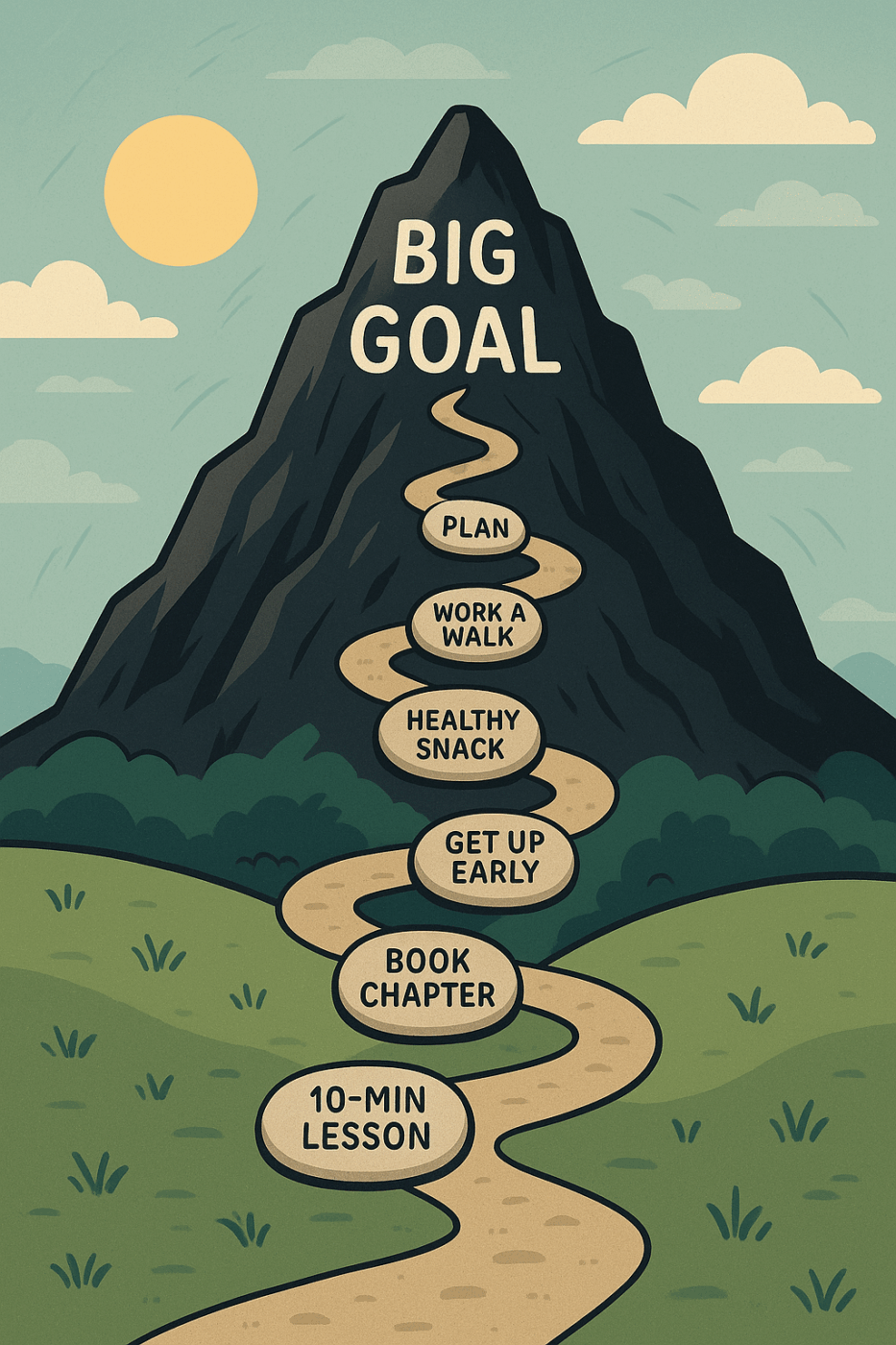
While small goals are a party for our brain, big goals are a five-alarm fire.
According to neuroscience, our brains have something called an “affective salience network,” which is a fancy term for a threat detector.
When we look at a huge, ambiguous goal like “get healthy,” this network can light up, perceiving the goal’s size and difficulty not as an exciting challenge, but as a genuine threat to our well-being.
The response is what’s called “decision paralysis.” It’s the feeling of being so completely overwhelmed that the safest and most logical course of action is to do nothing at all.
The simplistic one percent formula and the “small chunks” consolation prize are the perfect antidote to this fear.

They take a scary, amorphous monster of a goal and turn it into a series of small, harmless, and distinctly non-threatening steps.
Our built-in bias for straight lines
Finally, humans are notoriously bad at understanding exponential growth.
We are creatures of linear thinking. We expect that if one hour of work produces one widget, ten hours will produce ten widgets.
Our brains like straight, predictable lines.
The 37x promise is an exponential curve, but we hear it as a straight line. We intuitively process it as “a little bit of effort every day adds up to a lot of effort,” which is true.
But what we don’t naturally grasp is the explosive, almost ludicrous nature of compounding, which is why the reality of diminishing returns feels like such a betrayal.
The simple, linear promise of “just do a little bit each day” is far more comfortable and neurologically intuitive than the complex, messy reality of how real growth actually works.
If your “life plan” currently lives in scattered notes, half-filled journals, and one forgotten Google Doc—you’re not alone. This video shows you how to build a life plan that survives reality, not just New Year energy.
Sharpening the Chisel, Not Just Hitting the Stone
Okay, so if the one percent improvement method isn’t a magic formula, and it’s not just a glorified to-do list, what is it?
It’s an engine. And to use it properly, you have to stop thinking about the finish line and start thinking about the machine.
The entire misunderstanding of the one percent method boils down to a single question, and it’s the most important one you can ask yourself about any goal: Are you managing a project, or are you building a system?
They sound similar. They are completely different animals.
Hitting the stone (managing a project)
This is what most of us do by default. We treat a goal like a finite task. It’s a block of marble, and our job is to chip away at it until it’s finished.
The goal is “Run a marathon,” so we follow a training plan. The goal is “Launch a product,” so we burn through the task list. Once you cross the finish line, the project is complete.
It works, but it’s exhausting, and you often end up right back where you started.
Sharpening the chisel (building a system)
This is the real work. The goal isn’t the marathon; it’s to “become a better runner.” The daily one percent improvement isn’t about adding another mile; it’s about improving your capacity. It’s about sharpening the tool that does the work.
For example: Say your goal is “I want to lose 20 pounds.”
Approach 1 (hitting the stone) is about simply breaking down the goal.
This is the classic approach. You treat “lose 20 pounds” as a project to be completed, and you break it down into a to-do list of tasks.
This is all about doing the work. It’s about chipping away at the 20-pound block of marble until it’s gone. It can be effective, but it relies heavily on willpower, and when the project is “done,” people often revert to old habits because the underlying system that made them unhealthy is still there.
Approach 2 (sharpening the chisel) is about improving the underlying system.
Here, the goal isn’t really to “lose 20 pounds.” The goal is to “become the kind of person who is consistently healthy and energetic.” For this, you focus on making small, permanent improvements to the systems that govern your health.
The first approach gets you to the finish line. The second one makes you a better runner for every race you’ll ever run. That’s the crucial difference.
And here is the kicker: even the original poster child for the one percent method, the British cycling team’s coach—Sir Dave Brailsford—eventually admitted this was the real secret.
In other words, you don’t win by improving a thousand random things. You win by relentlessly improving the handful of things that truly matter—the core system.
How to Sharpen Your Chisel
The whole point of the one percent improvement method isn’t about more work; it’s about smarter work. It’s about moving from brute force to intelligent design.
So how do you do that? It’s a three-step process.
Step 1: Find the high-leverage bottleneck
You can’t improve everything at once. Trying to do so is the fastest way to burn out. The secret is to find the few things that, if improved, would make everything else easier.
💡 Pro Tip: If everything feels important, nothing is. Improvement begins the moment something becomes skippable on purpose.
The business approach: Pareto Principle
In business, this is called the Pareto Principle, or the 80/20 rule. It’s the observation that, in most systems, roughly 80% of the problems come from only 20% of the causes.
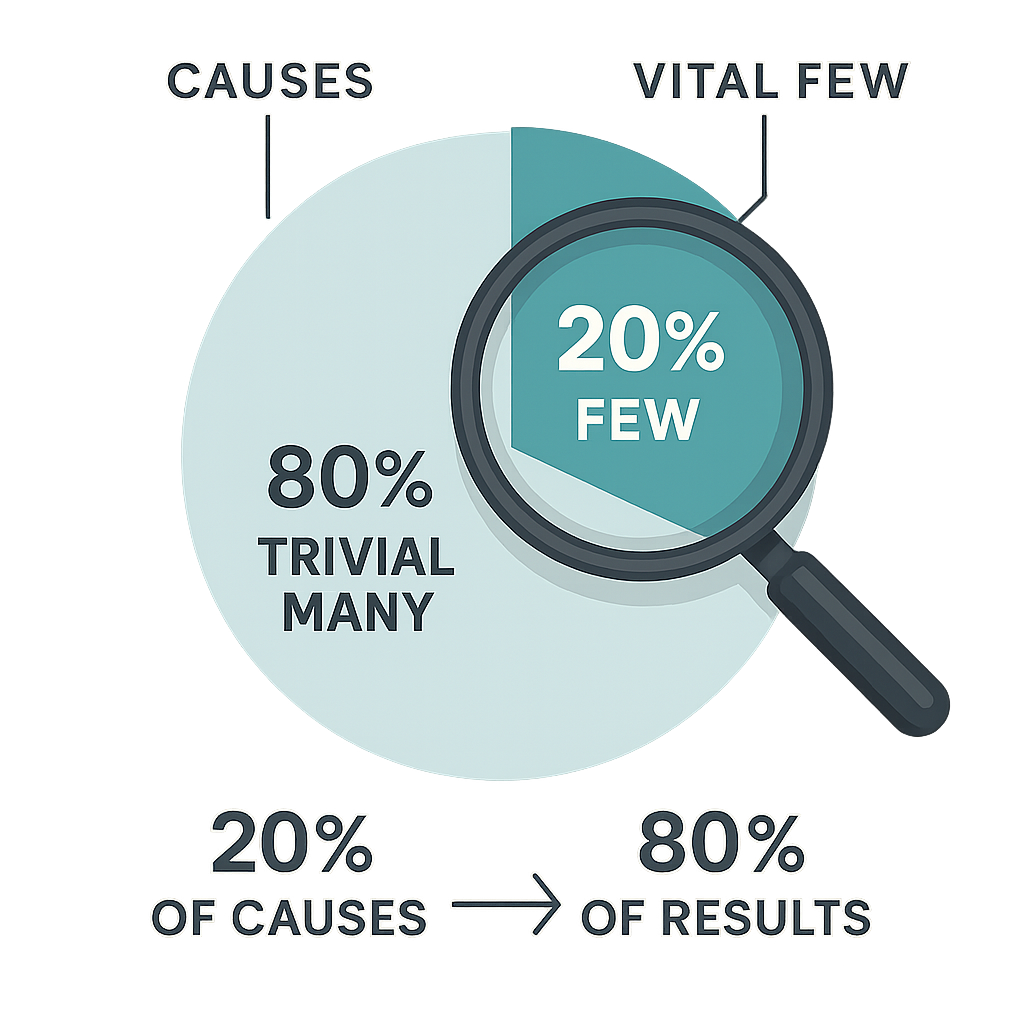
So, smart companies don’t try to fix everything; they find that “vital few” 20% and focus all their energy there.
Your approach: find the real point of failure
You don’t need a business degree to do this. You just need to be honest and find your bottleneck(s).
- Your goal: “I want to eat healthier”
- The wrong focus: Trying to overhaul your entire diet, replace every item in your pantry, and become a Michelin-star chef of kale salads overnight
- The bottleneck: After a moment of honest reflection, you realize 80% of your bad eating habits happen after 9 p.m., when you’re tired and your willpower is shot. Late-night snacking isn’t just a problem; it’s the problem. That’s your high-leverage bottleneck
Step 2: Define a “chisel-sharpening” habit
Once you’ve found your bottleneck(s), the temptation is to attack them with brute force.
If late-night snacking is the problem, the brute-force solution is to clench your fists and swear, “I will not snack!” This is a terrible plan. It relies on willpower, which is famously unreliable.
The one percent system-building approach isn’t about more willpower; it’s about better design. You need to define a small, repeatable habit that improves your system, not just your output. You need to sharpen the chisel.
The business approach: design the system first
A medtech company in one study wanted to implement continuous improvement.
Naturally, they didn’t tell their employees to “be more innovative.” That would be absurd.
Instead, they designed a new, streamlined system for employees to submit and track their improvement ideas. They didn’t focus on the outcome (more ideas); they focused on building a better machine for producing ideas.
They sharpened the chisel.
Your approach: reduce the friction
You can do the same thing with your snacking problem. The system that leads to late-night snacking isn’t a moral failure; it’s a design failure. So, redesign it.
- The wrong habit (brute force): “I will use willpower to not eat cookies at 9 p.m.”
- The chisel-sharpening habit (system design): “Every evening after dinner, I will spend two minutes preparing a healthy, genuinely appealing alternative snack and placing it at the front of the fridge”
In this example, you’re not resisting temptation; you’re making the good decision one percent easier and the bad decision one percent harder.
Step 3: Create a feedback loop
You now have a bottleneck and a chisel-sharpening habit. Now, the final piece of the puzzle is figuring out if your new habit is actually, you know, working.
A system without feedback is just a guess. You need to know if you’re making progress, and for that, you need data.
This sounds intimidating, but it doesn’t have to be.
The business approach: test everything
Hospitals are complex systems, and for a long time, improvement was based on expert opinion and educated guesses.
Then, a hospital system in New York, NYU Langone Health, decided to stop guessing. They started running rapid A/B tests on their own internal processes. They didn’t just assume a new procedure was better but actually tested it against the old one and let the data decide. They built a feedback loop right into their operations.
Your approach: be a scientist, not a critic
You don’t need a research grant to do this for yourself. You just need to be a little more curious and a little less judgmental.
- The wrong method (self-criticism): You try your new snack habit for a few days. One night, you slip up and eat the cookies. You immediately declare the entire experiment a failure and yourself a disappointment
- The feedback loop (scientific method): You treat it like an experiment. At the end of the week, you ask simple questions and write down the answers: How were my energy levels this week? Did the new snack actually help? What were the conditions on the night I slipped up?
Now, instead of judging yourself, you’re collecting data. And that’s the goal of a feedback loop: to give you the information you need to make the next one percent improvement to your system.
Maybe the healthy snack wasn’t appealing enough. Maybe you need an earlier bedtime. The feedback loop turns a “failure” into a useful piece of data for the next experiment.
From Theory to Action: Building Your System in ClickUp
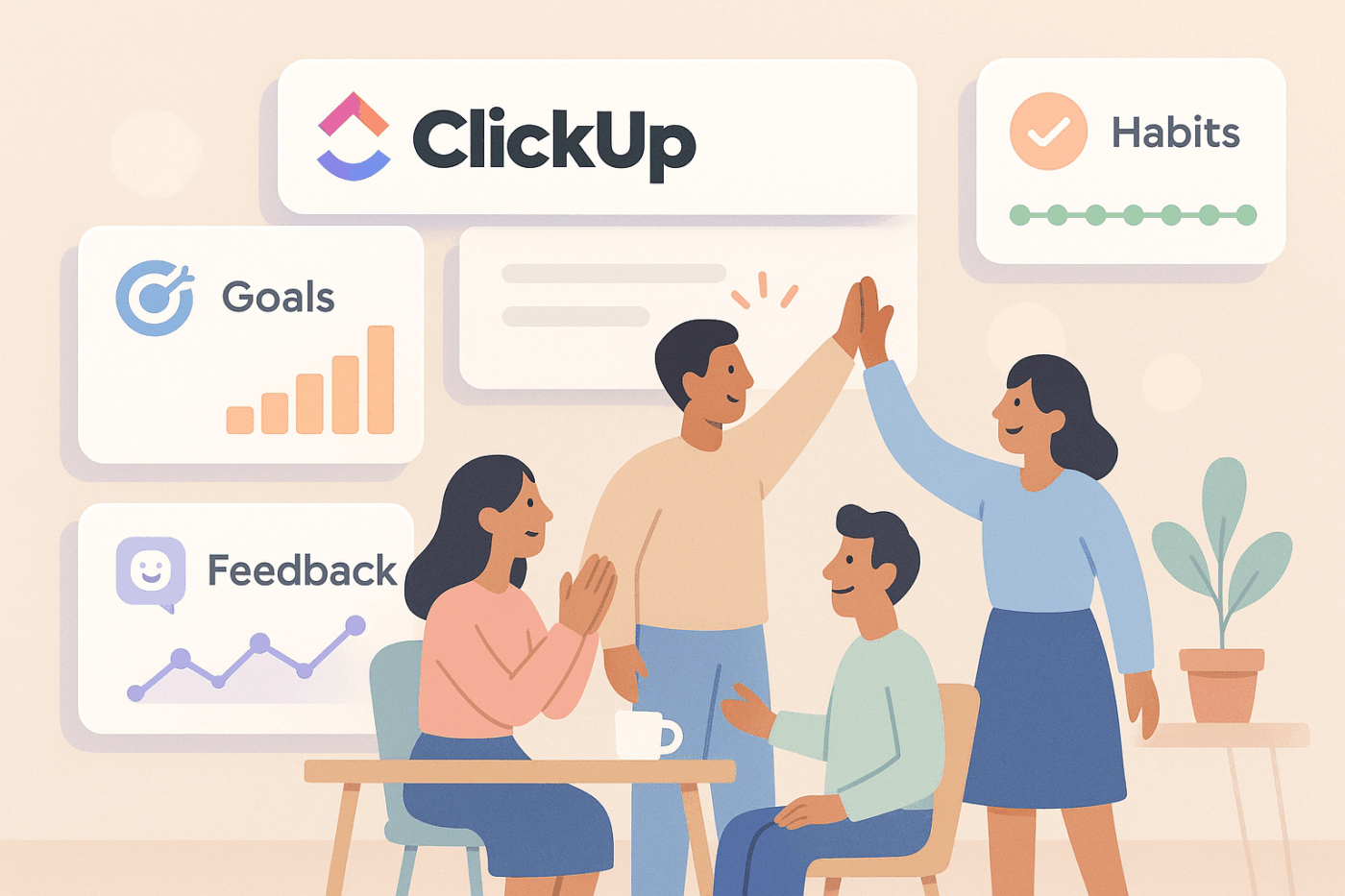
It’s one thing to understand the philosophy of system improvement. It’s another thing to actually do it.
The enemy of any good system is friction—the little annoyances, forgotten tasks, and mental clutter that make it easier to just give up.
A truly effective system, therefore, doesn’t run on willpower, but it can run on a platform like ClickUp (which, by the way, is free to use!)
We’re not trying to find a better to-do list to manage your project of “hitting the stone.” Instead, we’re using a workspace designed to help you build, manage, and refine the engine you’re using to “sharpen the chisel.”
System tracking, not task ticking
A project has a finish line—but a system has a trajectory.
To know whether your one-percent improvements are actually working, you need to measure the quality of the output, not just the number of tasks checked off.
Instead of tracking “Did I do the thing?”, you track “Is the thing getting easier / faster / better?”
In ClickUp, you can do this without building a complicated habit journal:
| What you’re improving | ClickUp Feature to Use | How it helps |
|---|---|---|
| Writing speed, research time, recovery time, etc. | Custom Fields | Add measurable data to each task instead of checking a box |
| Progress trends over weeks/months | ClickUp Dashboards | Turn your improvements into visual graphs instead of mental guesses |
| Detecting friction or plateaus | ClickUp Automations + Task Views | Trigger reminders or flags when a metric drops or stalls |
📌 Micro-Win Mindset
Don’t ask: “What did I finish today?”
Ask: “What became easier today?”
This is how you stop treating improvement like a checklist—and start treating it like an evolving system.
If Custom Fields and Dashboards show what is happening, ClickUp Brain shows why — and what to fix next.
ClickUp Brain: Your system’s brutally honest analyst
One of the hardest parts of system improvement is getting an objective view of what’s actually working. Our brains are great at telling stories, but terrible at seeing patterns. ClickUp Brain acts as your personal analyst, replacing guesswork with data.

It’s the perfect tool for creating the feedback loop we talked about. Instead of just feeling like you’re making progress, you can actually know.
🧠 Dopamine ≠ Development
Checking a task off a list isn’t growth — it’s just brain candy. Improvement isn’t the same as activity.
- Ask it to find bottlenecks: You can ask questions like, “Which writing tasks took longer than expected this month?” to instantly identify friction in your system
- Get automated progress reports: Use it to generate weekly summaries of all your completed “chisel-sharpening” tasks. It can surface patterns, blockers, and wins in real time, turning you from a critic of your own work into a scientist
- Generate new improvement ideas: When you’re stuck, you can use it to brainstorm the next one percent improvement. For example: “Give me five ways to streamline my article outlining process”
🤖 Bonus: We built an AI agent specifically to help you track your personal goals! Check it out now and see how it can help you achieve more with less.
ClickUp Personal Habit Tracker Template
A system is built on a foundation of consistent, repeatable actions.
The ClickUp Personal Habit Tracker Template provides the perfect framework for isolating and tracking the specific, high-leverage “chisel-sharpening” habits we identified earlier.
It’s not for tracking a hundred random habits; it’s for focusing on the few that actually upgrade your system.
- Isolate your key habits: Create tasks for the specific system improvements you’ve defined, like “Prep healthy alternative snack” or “Read 15 pages on the craft of writing
- Visualize consistency: Use the ClickUp Table View to get a simple, visual overview of your streaks. With this, you’re seeing collected data on how consistently you’re executing on your system improvements
- Track progress with Custom Fields: The template’s Progress custom field gives you an immediate, at-a-glance status check, turning a series of small actions into a measurable trend
ClickUp 75 Hard Wellness Challenge Template
Sometimes, a system needs more than a gentle nudge; it needs a full-on sprint to get it off the ground. While designed for a specific challenge, the structure of the ClickUp 75 Hard Wellness Challenge Template is a masterclass in managing an intensive, multi-faceted improvement project.
Its structure can be easily repurposed for any concentrated effort, like a “30-day coding refactor” or a “quarterly sales process overhaul.”
- Built-in feedback loops: The template’s structure for Weekly Assessments is a perfect, pre-built feedback mechanism. It forces you to pause, analyze the data from the past week, and make intelligent adjustments to your system for the week ahead
- Clear progress stages: Its Custom Statuses (“I Did It,” “In Progress,” “To Do”) provide a clear and satisfying sense of momentum during a difficult push, turning a mountain of work into a series of manageable stages
Where the One Percent Method Fits and Fails
A brilliant strategy applied to the wrong problem is just a fancy way to fail.
The one percent method is an exceptional strategy for optimization. But treating it as the answer to every question isn’t the way to go.
Instead, you have to understand when it’s the perfect move, and when it’s completely irrelevant.
Where the one percent method fits
The one percent method isn’t a lone wolf. It works best as part of a team. Dropping it into a strategic vacuum is just a lot of horsepower with nowhere to go.
To get the most out of it, you need to pair it with frameworks that provide direction and clarity.
One percent + OKRs
Objectives and Key Results (OKRs) are for setting wildly ambitious, slightly scary goals.

The Objective is the big, inspiring destination (“Become the recognized thought leader in our industry.” The Key Results are the measurable signposts that tell you if you’re getting there (“Increase organic traffic by 40%”).
- Where it fits: OKRs provide the “what” and the “why.” They are the architectural blueprint for the cathedral you want to build. But they famously don’t tell you how to lay the bricks
- The synergy: The one percent method provides the “how.” You use it to build sustainable, daily systems—the “chisel-sharpening” habits—that will actually move the needle on your Key Results
One percent + 4 Disciplines of Execution (4DX)
4DX is a framework for cutting through the “whirlwind” of daily tasks to focus on what’s critical.
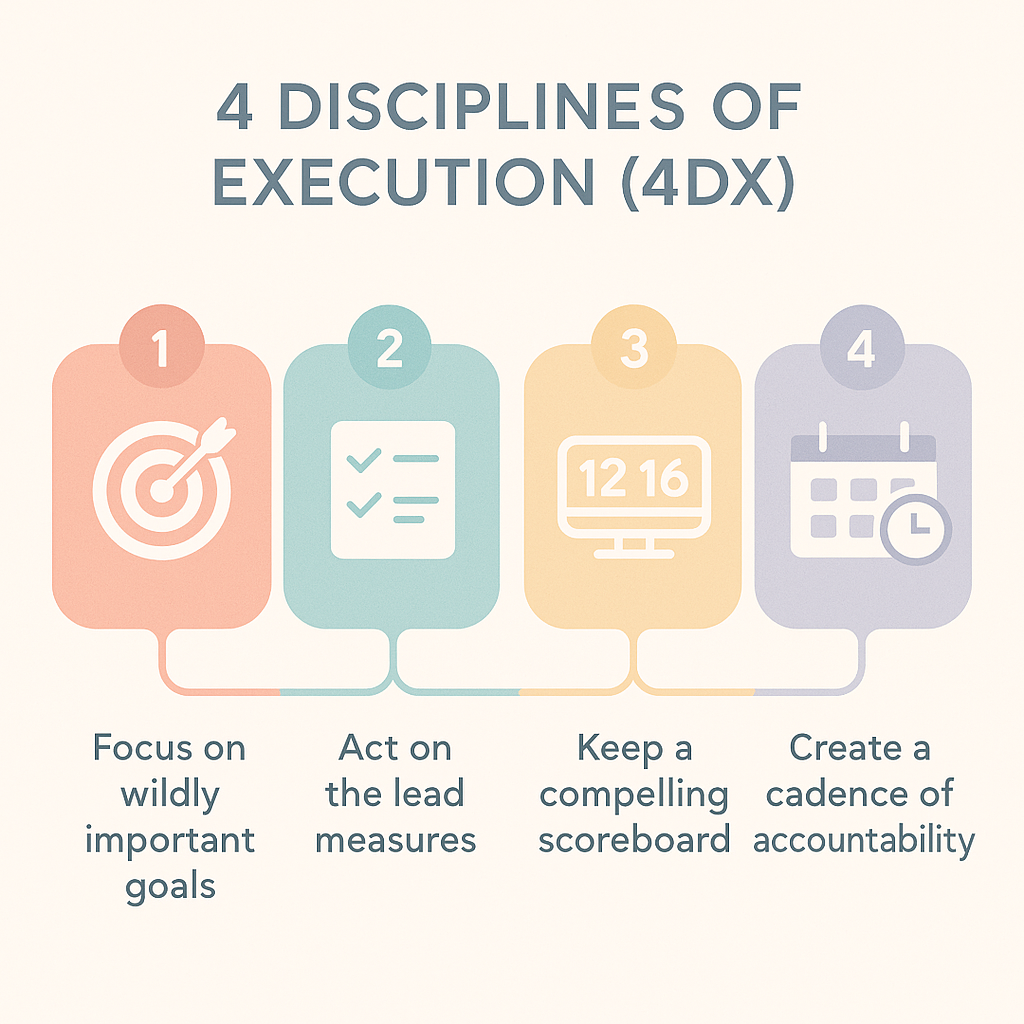
It demands you identify a “Wildly Important Goal” (WIG), focus on the “Lead Measures”, keep a compelling scoreboard, and create a performance accountability system.
These are all high-leverage actions that, if you do them, will inevitably drive the success of the goal.
- Where it fits: 4DX is brilliant at forcing focus and identifying the most important levers to pull. It tells you exactly which game you should be playing
- The synergy: The one percent method is the perfect tool for executing on those lead measures. If your lead measure is “contact five new prospects a day,” your one percent improvement is designing a slightly better email template or finding a way to streamline your research process by two minutes per prospect
One percent + Getting Things Done
Unlike the one percent method, the Getting Things Done (GTD) method is not a goal-setting system; it’s a sanity-preservation system.
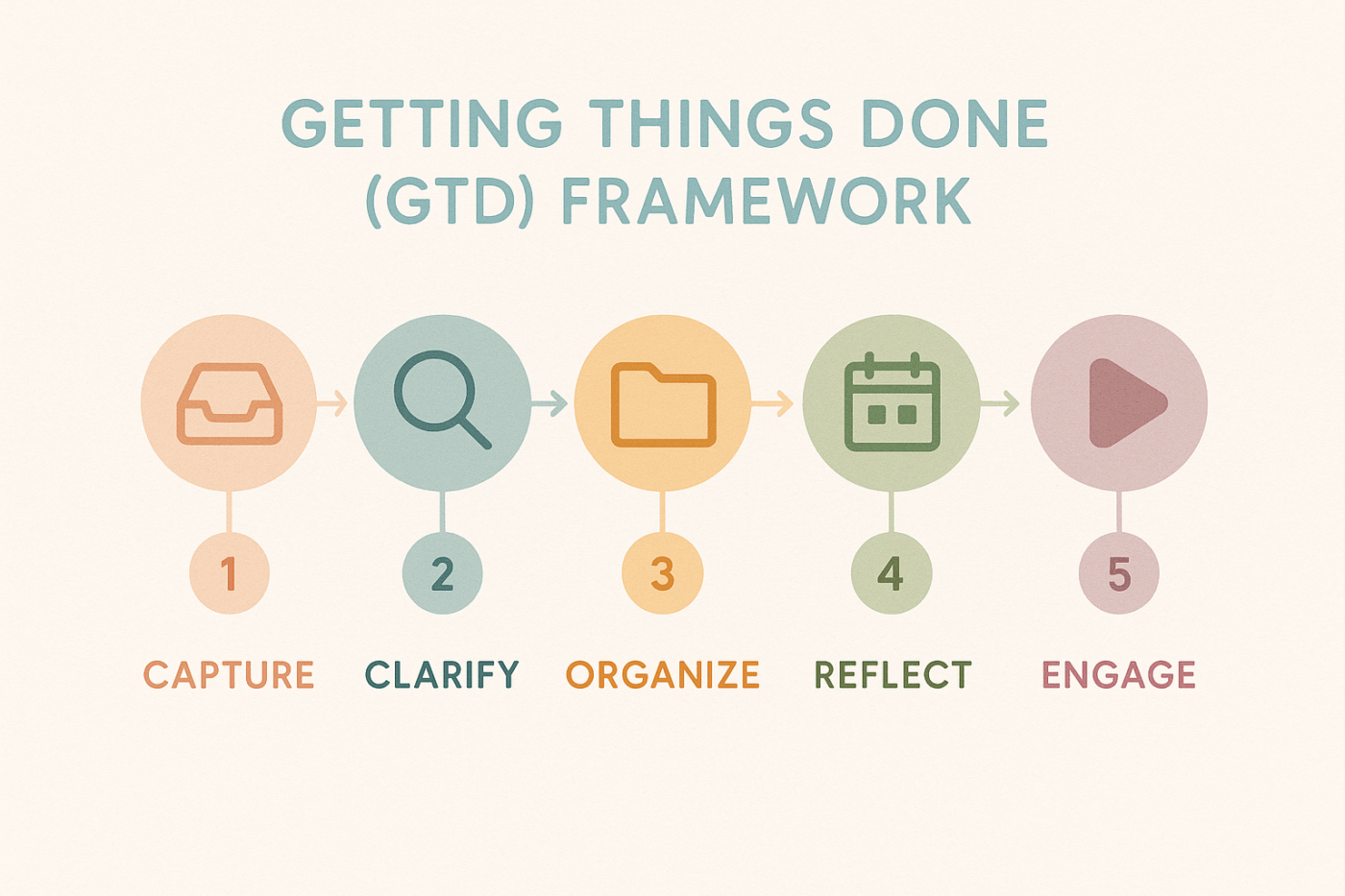
The GTD method’s entire purpose is to get commitments, ideas, and tasks out of your head and into a trusted external system, freeing up your mental bandwidth for actual, high-level thinking.
- Where it fits: GTD is the janitor that cleans up your messy mental workspace. It creates the clarity and focus you need to even think about improvement
- The synergy: You can’t sharpen your chisel if your workbench is buried under a mountain of junk. GTD clears the junk. It provides the mental peace required to step back, identify your bottlenecks, and thoughtfully design the one percent system improvements that matter
Where the one percent method fails
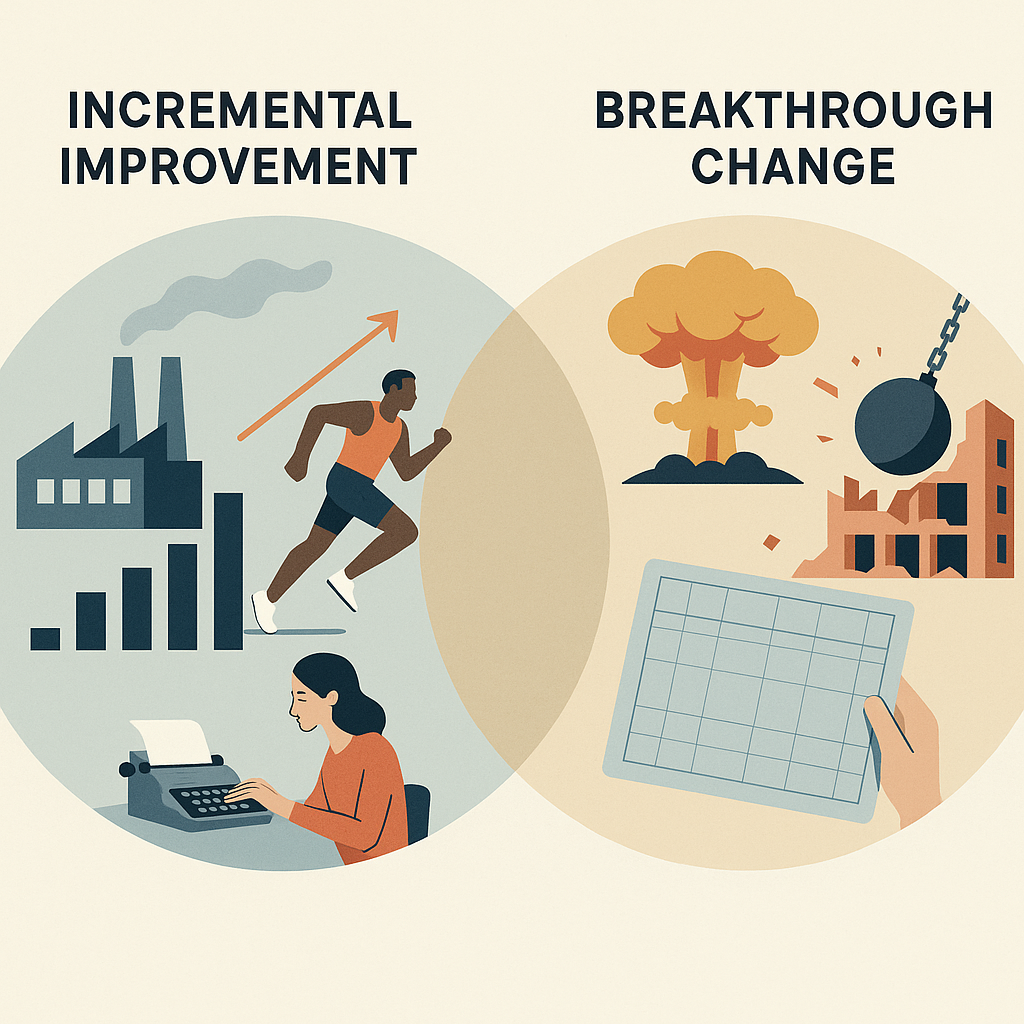
Some situations need more than incremental improvement; they need a stick of dynamite.
Sticking with the one percent method in these situations is a recipe for becoming the world’s most efficient, perfectly optimized manufacturer of horse-drawn buggies in a world that’s just invented the automobile.
Here’s what you could consider instead.
Breakthrough improvement
This is for when you need a vast, non-linear leap. You’re not trying to make the process one percent more efficient; you’re aiming for a 50% jump that requires a complete rethink of how things are done.
For example, think of a manufacturing plant with a safety record that’s starting to look like a horror movie. You don’t aim to make things one percent safer each month. That’s a great way to end up in court.
You need a breakthrough—a massive, immediate overhaul of everything to slash incidents by 50% or more, right now.
💡 Pro Tip: You can’t A/B-test your way out of a burning building. Some problems need demolition, not refinement.
Business process reengineering (BPR)
This is even more dramatic.
Say you want to improve your house. BPR isn’t really about improving the house; it’s about starting over with a blank sheet of paper and asking, “If we were building this from scratch today, what would it look like?” It’s the corporate equivalent of tearing your house down to the studs.
For example, imagine a bank in the internet age still approving mortgages with paper forms and a fax machine. The process takes 60 days, while a new online competitor does it in 24 hours. Improving the fax machine’s speed by one percent is a pointless optimization of a broken system.
BPR says you throw the whole thing in a dumpster, start with a blank sheet of paper, and design a process for the world that actually exists.
📘 Read More: Best Process Improvement Methodologies to Follow
Stop Counting, Start Designing
So, where does this leave us?
The promise of becoming 37 times better in a year isn’t a myth, but it’s not a universal law either. It’s a piece of conditional math that works beautifully in domains where compounding is a real force, and falls apart in the face of human biology and the laws of physics.
The frustration you’ve felt with the one percent method of continuous improvement was never a personal failure. It was the result of a translation error.
A powerful philosophy of industrial design was turned into a simple mantra for personal to-do lists, and the most important part was lost along the way.
We were taught to be accountants of our own progress, meticulously tracking tiny, incremental tasks. But the real goal was never to get better at counting. It was to get better at designing.
The true power of this idea has nothing to do with a specific number. It’s a mindset. It’s the shift from asking, “How do I finish this project?” to “How do I build a better engine for every project to come?”
It’s the subtle but profound difference between hitting the stone and sharpening the chisel. That’s the only thing that ever mattered.
Frequently Asked Questions
What does the one percent improvement method mean?
It means you’ve been focusing on the wrong thing. The popular version tells you to chip away at a goal. The real method tells you to stop and sharpen the chisel you’re using. It’s a philosophy about making the thing that does the work better, not just doing more of the work.
How long does it take to see results?
The moment you make a one percent improvement, your system is better. Seeing results in your outcomes—the big, flashy goals—is another story. Beginners see them fast because everything is a mess. Experts barely see them at all, because each tiny gain is paid for in blood, sweat, and boredom.
Is the one percent method the same as Kaizen?
They’re related, but not the same. Kaizen is the serious, industrial grandparent from the factory floors of Japan. The one percent method is its slicker, more modern grandchild, packaged in a best-selling book for the rest of us. Same DNA, different outfits.
How can I track my one percent improvements?
Stop tracking your to-do list. Start tracking two things instead: first, did you consistently do your “chisel-sharpening” habit? And second, is the system actually getting better? Is your writing speed increasing? Is your recovery time after a workout decreasing? A platform like ClickUp is built for this—it lets you track the high-level system goal, not just the daily noise.
Can businesses use the 1% method?
Can they use it? They invented it. The whole idea was born on the factory floors of companies like Toyota long before it became a personal productivity trend. Its natural habitat is organizational, not personal.

